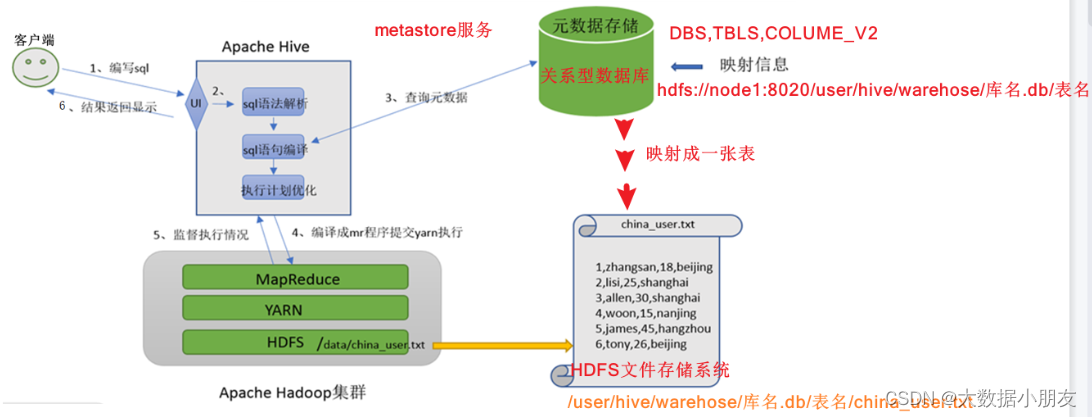Hadoop数据库ID获取之道:理解HDFS和Hive的ID机制
发布时间: 2024-07-28 14:51:11 阅读量: 28 订阅数: 46 


分布式数据库Hive笔记_HDFS_Hadoop_分布式数据库

# 1. Hadoop数据管理概述**
Hadoop是一个分布式数据管理平台,它使用ID机制来管理和组织数据。ID机制是Hadoop中一个重要的概念,它确保了数据的唯一性和完整性。
ID机制在Hadoop中主要用于两个目的:
* **标识数据:** ID用于唯一标识Hadoop中的数据,例如文件、块和表。这使Hadoop能够快速高效地查找和访问数据。
* **管理数据:** ID还用于管理Hadoop中的数据,例如移动、复制和删除数据。通过使用ID,Hadoop可以有效地执行这些操作,而不会丢失或损坏数据。
# 2. HDFS中的ID机制
### 2.1 文件ID(File ID)
#### 2.1.1 文件ID的生成和存储
文件ID(File ID)是HDFS中标识文件的唯一标识符。它由NameNode生成,并存储在fsimage和edits日志中。fsimage是NameNode的持久化元数据存储,而edits日志记录了对元数据的更改。
#### 2.1.2 文件ID的用途
文件ID用于以下目的:
- **文件识别:**文件ID唯一标识HDFS中的每个文件。
- **元数据管理:**NameNode使用文件ID来管理文件元数据,例如文件大小、块列表和权限。
- **数据恢复:**在发生故障的情况下,NameNode可以使用文件ID来恢复文件元数据。
### 2.2 块ID(Block ID)
#### 2.2.1 块ID的生成和存储
块ID(Block ID)是HDFS中标识块的唯一标识符。它由DataNode生成,并存储在块元数据中。块元数据包含有关块的信息,例如块大小、块位置和校验和。
#### 2.2.2 块ID的用途
块ID用于以下目的:
- **块识别:**块ID唯一标识HDFS中的每个块。
- **数据存储:**DataNode使用块ID来存储和检索数据块。
- **数据完整性:**DataNode使用块ID来验证数据块的完整性。
### 代码示例:获取文件ID
```python
from hdfs import Client
# 创建HDFS客户端
client = Client('http://localhost:9000')
# 获取文件ID
file_id = client.get_file_id('/user/hadoop/input.txt')
print(file_id)
```
**代码逻辑分析:**
该代码示例使用HDFS Python客户端获取文件的File ID。它首先创建了一个HDFS客户端,然后使用`get_file_id()`方法获取指定文件的文件ID。
**参数说明:**
- `client`:HDFS客户端对象。
- `path`:要获取文件ID的文件路径。
### 代码示例:获取块ID
```python
from hdfs import Client
# 创建HDFS客户端
client = Client('http://localhost:9000')
# 获取块ID
block_ids = client.list_block_ids('/user/hadoop/input.txt')
for block_id in block_ids:
print(block_id)
```
**代码逻辑分析:**
该代码示例使用HDFS Python客户端获取文件的块ID列表。它首先创建了一个HDFS客户端,然后使用`list_block_ids()`方法获取指定文件的块ID列表。
**参数说明:**
- `client`:HDFS客户端对象。
- `path`:要获取块ID的文件路径。
# 3. Hive中的ID机制
### 3.1 表ID(Table ID)
#### 3.1.1 表ID的生成和存储
Hive中的表ID是一个32位的整数,由Hive元数据存储系统自动生成。表ID在表创建时生成,并存储在元数据表`TBLS`中。
#### 3.1.2 表ID的用途
表ID用于唯一标识Hive中的表。它用于以下目的:
- 在元数据表中引用表
- 在查询中引用表
- 在数据文件和目录中标识表数据
### 3.2 分区ID(Partition ID)
#### 3.2.1 分区ID的生成和存储
分区ID是一个32位的整数,由Hive元数据存储系统自动生成。分区ID在分区创建时生成,并存储在元数据表`PARTITIONS`中。
#### 3.2.2 分区ID的用途
分区ID用于唯一标识Hive中的分区。它用于以下目的:
- 在元数据表中引用分区
- 在查询中引用分区
- 在数据文件和目录中标识分区数据
### 3.3 ID获取实践
#### 3.3.1 通过命令行工具获取表ID和分区ID
```bash
# 获取表ID
hive -e "SELECT table_id FROM TBLS WHERE table_name = 'my_table';"
# 获取分区ID
hive -e "SELECT partition_id FROM PARTITIONS WHERE table_name = 'my_table' AND partitio
```
0
0





